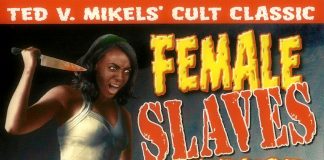Let’s face it: 1990 was basically the after party for the ’80s, as the cultural trends of the old decade carried over into the new one — or don’t you remember the shoulder pads that could impale a horse? As such, even though The Suckling came out in 1990, it continued the marginalization of black characters in horror movies that became a staple of the ’80s, when blacks were deemed important enough to include but not important enough to star. And what happens to characters in horror movies who aren’t the star? They ded.
What makes The Suckling stand out, though, is that it features not just one black character (as was common in the ’80s; hey, it’s “the black guy!”) or even two, but rather THREE whole black folks — four if you count a random police officer who shows up at the end of the film. Unfortunately, the reason there are so many people of color (there’s also an Asian woman and what could be a Latina or two) is that the film is set almost entirely in a seedy brothel-slash-unlicensed abortion clinic. And if ’80s cinema taught us anything, it’s that if there’s petty crime going on, it’s bound to involve someone black.
That said, the interesting thing about the black characters in The Suckling is that they’re arguably the most moral and sympathetic in the entire movie — and thus, by horror logic, the most worthy of surviving. Granted, in a film full of dirtbags — including a boyfriend willing to trick his girlfriend into an abortion, an abortionist willing to drug and perform the operation on an unwilling patient, the abortionist’s violent ex-con son, a pervy businessman john who looks down on the prostitutes (although he’s addicted to S&M) and a loudmouth hooker who shoots down every plan of action but can’t come up with one of her own — that’s like praising someone as the smartest Kardashian.
The first black character is Bertha (Antoinette Greene), the simple-minded assistant to the head of the “facility,” Big Mama, who blindly follows orders and naively begins every sentence with “Big Mama says…” There’s also Sheryl (Susan Brodsky), a hooker with a heart of gold who’s the only one to comfort the white lead, Rebecca, after her shitty boyfriend Phil tricks her into having an abortion. Then there’s Sherman (Gerald Preger), Big Mama’s security/doorman, a strapping military vet whose take-charge approach when everyone finds themselves trapped inside the building by Rebecca’s giant killer mutant fetus (Did I mention there’s a giant killer mutant fetus? There’s a giant killer mutant fetus.) is reminiscent of — Lord have mercy on me for making this comparison — Ben from Night of the Living Dead.
By all established genre reasoning, Sherman should be the hero in this film. He’s cool, handsome (sporting a bushy ’80s ‘stache and a then-stylish shag, the black man’s answer to the mullet), physically fit and calm under pressure, yet still commanding enough to take control and dictate a plan of action. He’s even courageous and selfless enough to save Phil’s life when the creature grabs hold of his leg. Most importantly, he serves as the foil to the primary non-fetal antagonist in the movie: Big Mama’s no-good son Axel, who threatens the safety of the others in the group. He even slaps Axel around, Ben-style, when he gets out of hand. For a while, I thought Sherman had a chance to save the day, especially considering “final girl” Rebecca is such a cowering, ineffectual mess throughout the film.
Except, he’s black.
So, of course, he — and Bertha and Sheryl — die. Hard. With a vengeance. In fact, he doesn’t even live as long as Axel or that louse Phil. Talk about white privilege.
Of course, sensitivity — cultural, racial or otherwise — isn’t a prime consideration for a flick about a murderous aborted fetus reanimated by toxic waste. This is a taste-optional B-movie in a morbidly lighthearted Troma vein that’s basically It’s Alive meets The Toxic Avenger. Its UK title, Sewage Baby, is actually more appropriate to the content and tone. The humor is lame, the acting is flat, the awkward direction uses some wonky camera angles and the effects are at times laughable (especially the crimes against stop-motion), but the toothy creature design is striking and frankly is the main selling point of the film. Too bad the monster appears on screen for only a few seconds at a time — no doubt to obscure the fact that it looks like a rubber-suited Power Rangers villain.


























This was a well-written review with astute observations. Indeed, petty crime insured the presence of blacks in films back then, for one thing. The fact that the black characters were the more moral one was another good observation.
When Sherman (Tim Martin Crouse), the “strapping military vet ” first appeared on screen, I couldn’t help thinking there was something very appealing about him. I enjoyed the comparison to NOTLD’s Ben.
In fairness, as much as the reviewer was unhappy about Sherman getting killed off, the whole idea of THE SUCKLING was for every character (except for the useless heroine, Rebecca) to die. (The complete massacre is what led to Rebecca’s mental breakdown.) In addition, NOTLD’s sole survivor, Ben, didn’t last either.
(Yep, the fact that massacre was the key element of the story is clear from the scroll at the movie’s beginning: “On April 1st 1973 the most bizarre event in all of Brooklyn’s modern history occurred. Twelve people, inhabitants of a (cathouse) and an illegal abortion clinic were all killed.” This raises two questions: 1) If this was “Brooklyn,” why did the madam (“Big Mama”) sound straight out of New Orleans, and 2) If Roe vs. Wade became the law in Jan. 22, 1973, why was this abortion clinic illegal?)
The reviewer lamented that Sherman should have been the film’s hero, but his death did not prevent him from indeed still being the hero. (Although the fact that he saved Phil was not a great heroic moment; anyone would have grabbed a knife to free Phil, once his leg got entangled in a tentacle. After Sherman’s departure, Phil was a sorry heroic substitute; in the finale, what prevented him from shooting the creature, who provided an easy target after having broken through the floor, and getting temporarily stuck…?)
I see Mr. Crouse continued in show business, even directing and writing a couple of movies. (The “Big Mama” actress appearing in both.) As physically impressive as he was (as the reviewer pointed out, handsome, too), his poor acting unfortunately was difficult not to notice. As did Bertha’s, who also caught my eye for being rather beautiful. Interestingly, the actress who played her, Antoinette Greene, went on to appear in numerous other fare (we may only imagine her acting improved).
Just a few notes, since the cast listing was indeed “wildly incomplete.” The IMDb has heroine Rebecca credited as “Lisa Petruno” (onscreen spelling: “Patruno”), but I am guessing that may have been “Candy,” the “loudmouth hooker.” (The film’s second name in the opening credits is “Marie Michaels”; there is a greater chance she is Rebecca. Also: What happened to the prettiest hooker (the bare-breasted one, seen in the freeze frame of the trailer, above) who was first seen with the whip? (A-ha, having watched the end of her scene over again, I see “Mary” was called downstairs to be driven home by her grandmother, so she would live to see another day. Alas, apparently never again in cinema, however; THE SUCKLING was her only moment in celluloid glory.)
There seems to be an error. Gerald Preger played Sherman and Tim Martin Crouse played Bill.
Good catch! Fixed it. Thx!